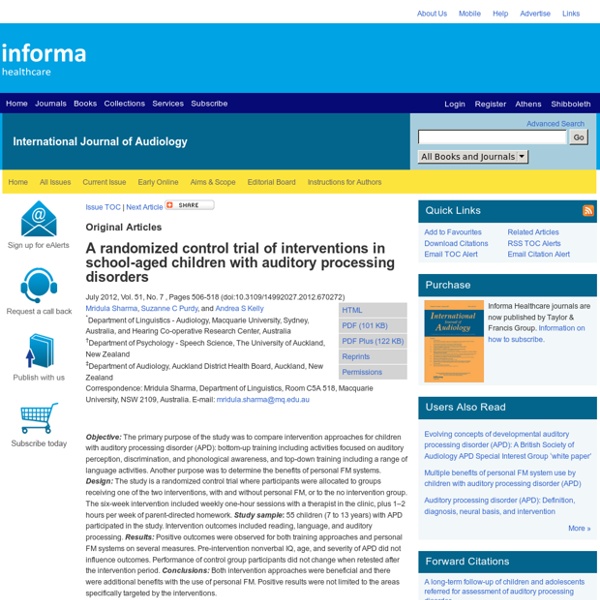



Auditory processing disorders in adults and children: Evaluation of a test battery Original Article Auditory processing disorders in adults and children: Evaluation of a test battery: Desórdenes del procesamiento auditivo en adultos y niños; evaluación de una batería de pruebas 2003, Vol. 42, No. 7 , Pages 391-400 †Correspondence: Karin Neijenhuis, University Medical Centre Nijmegen, 811 Department of Otorhinolaryngology, PO Box 9101, 6500 HB, Nijmegen, The Netherlands k.neijenhuis@kno.umen.nl A Dutch test battery comprising six different tests for auditory processing disorders was evaluated in a group of 49 adults and children (age 8–57 years) with auditory complaints despite normal audiometric thresholds.
Living with APD - A Teens Point of View: July 2011 In yesterdays blog, I wrote about how Auditory Processing Disorder affects those who have it in the 'real world' outside the school setting, as much as it does in the school setting. So, tonight, I want to talk a little more about it's challenges for a high school student in the school setting since thats where us teens find it the most! 1. In the classroom: This is one area where it can be very overwhelming, pressuring, and difficult for a teenager with apd, and there are many different reasons for that!-> Background Noise This is a major issue because it is very hard for someone with APD to block this out while trying to concentrate on doing their work, listening to the teacher, or doing something more demanding such as a test or a quiz. -> ...and the answer is? ->Im Confussed!? 2. -> Studying To continue on from the following point, studying is a much the same, yet a whole other ball park! -> Sleep? -apdteen23
Auditory processing disorders, verbal disfluency, and learning difficulties: A case study Original Article Auditory processing disorders, verbal disfluency, and learning difficulties: A case studyProblemas del procesamiento auditivo, de la fluidez verbal y del aprendizaje: reporte de un caso 2007, Vol. 46, No. 1 , Pages 31-38 (doi:10.1080/14992020601083321) Benoît Jutras, Benoît Jutras, Josée Lagacé, Annik Lavigne, Andrée Boissonneault, and Charlen Lavoie 1School of Speech-Language Pathology and Audiology, University of Montreal, and the Sainte-Justine Hospital Pediatric Research Centre, Canada 2Audiology and Speech-Language Pathology Program, University of Ottawa, Canada Currently at School of Speech-Language Pathology and Audiology, University of the Sainte-Justine Hospital Pediatric Research Centre †Correspondence: Benoît Jutras, School of Speech-Language Pathology and Audiology, University of Montreal, P.O.
Living and Working with a Central Auditory Processing Disorder (CAPD) By: Judith W. Paton The easiest, quickest way to communicate is simply to say something and then deal with the other person's reply, right? Right, unless your listener has a CAPD (Central Auditory Processing Disorder), then your remark might come through with certain words drowned out by other noises, or with some words sounding like different words or as meaningless strings of verbiage. You might begin to suspect this when the other person's expression doesn't register understanding, or if he "answers the wrong question," or he asks you for additional information which most people would have been able to infer from what you just said. Most of us aren't that sophisticated about CAPDs, however, and are much more likely to wonder if the listener is just not very intelligent or doesn't really care about us and what we are saying. A CAPD is a physical hearing impairment, but one which does not show up as a hearing loss on routine screenings or an audiogram. Talks or likes T. 1.
Auditory rehabilitation for interaural asymmetry: Preliminary evidence of improved dichotic listening performance following intensive training Original Article Auditory rehabilitation for interaural asymmetry: Preliminary evidence of improved dichotic listening performance following intensive training 2008, Vol. 47, No. 2 , Pages 84-97 (doi:10.1080/14992020701770835) Deborah W. 1Department of Communication Science and Disorders, University of Pittsburgh, USA 2Understanding U, Gainesville, Florida, USA †Correspondence: Deborah W. Children with dichotic left ear deficits received intensive training in phase I and phase II clinical trials designed to establish the efficacy of directly training dichotic listening.
eartroubles.com Evaluation of auditory processing disorders after whiplash injury Original Evaluation of auditory processing disorders after whiplash injury 2006, Vol. 4, No. 4 , Pages 191-201 (doi:10.1080/16513860601011755) †Correspondence: Ad Snik, Audiological Centre, ENT Department, University Medical Centre St. Whiplash patients often have many subjective complaints, such as headaches, concentration difficulties, fatigue, neck pain and vertigo.
It takes a team to differentially diagnose APD Chermak, Gail D. PhD Section Editor(s): Musiek, Frank E. PhD Abstract How can one distinguish auditory processing disorder from multimodal or supramodal disorders that may involve the auditory modality? Author Information Pathways editor Professor of Audiology and Chair of the Department of Speech and Hearing Sciences at Washington State University. Correspondence to Dr. Readers are invited to suggest future topics to Frank E. Auditory processing disorder (APD) is a deficit in the processing of information that is specific to the auditory modality.1 APD typically involves deficits in dichotic listening, selective attention, and temporal processing. Given the heterogeneous nature of APD and the range of listening and learning deficits that often accompany it, comprehensive evaluation requires a multidisciplinary team approach. 1. 2. 3. 4. 5. 6. 7. 8. 9. 10. 11. 12. 13. 14. 15. 16.
Identification of binaural integration deficits in children with the Competing Words Subtest: Standard score versus interaural asymmetry Discussion Paper Identification of binaural integration deficits in children with the Competing Words Subtest: Standard score versus interaural asymmetryIdentificación del déficit de integración binaural en niños, utilizando la prueba competitiva con palabras: calificación estándar vs asimetría interaural 2006, Vol. 45, No. 4 , Pages 200-210 (doi:10.1080/10503300500485631) †Correspondence: Deborah W. Moncrieff, University of Connecticut, 850 Bolton Road, Unit 1085, Storrs, CT, 06268 debbie.moncrieff@uconn.edu The Competing Words Subtest is a commonly used dichotic listening test for assessing binaural integration in children suspected of having an auditory processing disorder.